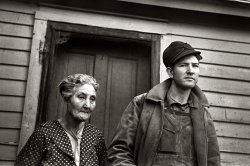
MAY CONTAIN NUTS

Search Shorpy
SHORPY ART

Framed or unframed, desk size to sofa size, printed by us in Arizona and Alabama since 2007. Explore now.
Join and Share
Ad-Free Shorpy
Shorpy is funded by you. Patreon contributors get an ad-free experience.
Learn more.

Recent comments
- Alas, hidden from view
- Exclusive pump
- Details, Details
- What's that building to the left of the tower?
- Coal Barges
- Bromo-Seltzer
- Inner harbor
- The Basin
- What a headache!
- Giant stepladder?
- Baldwin 62303
- Baldwin VO-1000
- Cold
- No expense spared
- Tough Guys
- Lost in Toyland
- And without gloves
- If I were a blindfolded time traveler
- Smoke Consumer Also Cooks
- Oh that stove!
- Possibly still there?
- What?!?
- $100 Reward
- Freeze Frame
- Texas Flyer wanted
- Just a Year Too Soon
- WWII -- Replacing men with women at the railroad crossing.
- Yes, Icing
- You kids drive me nuts!
- NOT An Easy Job
Member Photos
The Shorpy
Print Emporium
Print Emporium
Search Shorpy
Search results -- 30 results per page
- Heavy Cream: 1940
- ... Accurate milk records of each cow are kept." Photo by Russell Lee for the Farm Security Administration. View full size.
Knudsen ... Posted by Dave - 10/17/2018 - 1:50pm -
![Heavy Cream: 1940 November 1940. "Tulare County, California. Son of worker weighing up milk at Mineral King cooperative farm. Accurate milk records of each cow are kept." Photo by Russell Lee for the Farm Security Administration. View full size.
KnudsenStill dealing moo juice in the Golden State, 78 years later.
What's left of Mineral King Ranch
32 + 10 + 6 + 1 =The sums of numbers must have carried more weight back then.
[Whatever that means. - Dave]
To equal 58?
Adding and subtractingI think it is 72(32+40) minus 14(6+8)= 58. The numbers are a bit hard to read.
Milk Scale and calendar"Milk scales typically came in 10-pound increments (as the scale slide is pulled down with weight, the hand goes around three times) for 30 pounds maximum weight and 20 pounds (again, the hand goes around three times) for 60 pounds maximum weight."
From
https://www.farmcollector.com/farm-life/milk-scales-milk-tester
The calendar is (most likely) from The Knudsen Milk Products Co. The earliest available city directory is dated 1957 when the company representative was Fred Olsson. I'm sure Fred could tell us who the young man might be.
(The Gallery, Agriculture, Russell Lee)](https://www.shorpy.com/files/images/SHORPY-8c00112a.thumbnail.jpg)
- Return Flight: 1938
- ... "House with unusual staircase." 35mm nitrate negative by Russell Lee for the Resettlement Administration. View full size.
Unusual ... Posted by Dave - 01/30/2017 - 8:46pm -
![Return Flight: 1938 November 1938. Mobile, Alabama. "House with unusual staircase." 35mm nitrate negative by Russell Lee for the Resettlement Administration. View full size.
UnusualFormer home of the Escher family.
Stairs for the ghostThose stairs don't seem able to support anyone weighing over 35 pounds, but they should be OK for the ghost on the right side of the porch.
[That is a corporeal entity standing on the porch behind the stairs. -tterrace]
When the bough breaks ....I definitely WOULD NOT carry a piano up those stairs! The only support is the corner post. Yikes!
(The Gallery, Mobile, Russell Lee)](https://www.shorpy.com/files/images/SHORPY-8a24850a.thumbnail.jpg)
- But Seriously: 1940
- ... truck. Oneida County, Idaho." Medium format negative by Russell Lee for the FSA. View full size.
And no straps to hold it all down. ... Posted by Dave - 08/15/2018 - 9:52am -
![But Seriously: 1940 August 1940. "Farm Security Administration cooperative truck. Oneida County, Idaho." Medium format negative by Russell Lee for the FSA. View full size.
And no strapsto hold it all down. Nicely packed perhaps, but wouldn't want to be driving in back of that truck.
StackingI love the simple, elegant yet unassailable logic to his packing of the sacks. It's a thing of beauty.
Cerealsly ...I presume?
Happy ManA happy man with a good harvest and a good truck. I bet it felt good to have a bit of prosperity after the depression.
[The grain and the truck belong to the cooperative, not the man. - Dave]
(The Gallery, Agriculture, Cars, Trucks, Buses, Russell Lee)](https://www.shorpy.com/files/images/SHORPY-8b25801a.thumbnail.jpg)
- Okie Near Muskogee: 1939
- ... Oklahoma." View full size. 35mm nitrate negative by Russell Lee, Farm Security Administration.
Vintage Ford Truck Just look at the ... Posted by Dave - 12/10/2007 - 1:42pm -
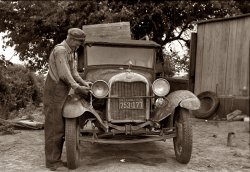
- Daddy Is a Trasher: 1939
- ... with some things he picked up." Medium format negative by Russell Lee for the Farm Security Administration. View full size.
Golf bag ... Posted by Dave - 05/27/2018 - 5:33pm -
![Daddy Is a Trasher: 1939 July 1939. "Children of May Avenue camp, Oklahoma City. Their father is a trasher and they are playing with some things he picked up." Medium format negative by Russell Lee for the Farm Security Administration. View full size.
Golf bagThat golf bag to the left appears to be in excellent condition. In today's collector's market it could easily go for $300-500.
Different nowToday he would be called a picker, and he might get his own show.
Complexion reflectionSeems like we don't see as many freckle-face kids anymore. Wonder why?
[Those aren't freckles. The boy has impetigo, or something like it. - Dave]
(The Gallery, Great Depression, Kids, Russell Lee)](https://www.shorpy.com/files/images/SHORPY-8b22572a.thumbnail.jpg)
- Near Ophir: 1940
- ... gauge railroad near Ophir, Colorado." Acetate negative by Russell Lee for the Farm Security Administration. View full size.
Barrels I ... Posted by Dave - 10/01/2018 - 10:52am -
![Near Ophir: 1940 September 1940. "Trestle of narrow gauge railroad near Ophir, Colorado." Acetate negative by Russell Lee for the Farm Security Administration. View full size.
BarrelsI see small platforms with steel barrels, placed at intervals along the far side. What purpose do the barrels serve?
[Fire extinguishers. - Dave]
It's a long way downHow 'bout that for a clever title for my comment?
Dual purposeIs that standard gauge also on the trestle?
**********
Thanks to both Steamcrane and Wormy for the guard rail information. I knew of standard gauge guard rails, but not the narrow gauge type.
As always, Shorpy is informative as well as artistic and entertaining.
Outside guard railsThe smaller section rails outside the running rails are intended to keep derailed cars from going completely off the trestle deck. Additionally, there are guard timbers at the ends of the ties as a last resort.
On a standard gauge railroad, the guard rails would be between the running rails, with the guard rails brought together at a point at the end. Not so good with tippy narrow gauge cars.
With modern welded rails, and very few bolted joints, the chance of a spontaneous derailment is greatly reduced, and the guard rails are now frequently omitted, especially if passenger trains do not use the line.
Also note the extended timbers on the near side, presumably to allow laying down planks to make maintenance work easier.
Safety RailsThe outer rails are there to keep the trucks traveling relatively straight over a trestle, viaduct, or bridge during a derailment. A rough ride but better than the alternative.
AcrophobiaI seem to have Ophir of heights.
(The Gallery, Railroads, Russell Lee)](https://www.shorpy.com/files/images/SHORPY-8b26089a1.thumbnail.jpg)
- Birds of a Feather: 1939
- ... market in Weatherford, Texas." 35mm nitrate negative by Russell Lee for the FSA. View full size.
First Mondays I'm thinking this was ... Posted by Dave - 09/09/2011 - 12:11pm -
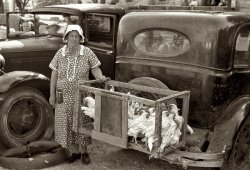
- Standardized: 1942
- ... With a Beauty Parlor for major overhauls. Photo by Russell Lee, Office of War Information. View full size.
Gas rationing? I was ... Posted by Dave - 05/30/2015 - 12:57am -
![Standardized: 1942 June 1942. "Tracy, California. Gasoline filling station." With a Beauty Parlor for major overhauls. Photo by Russell Lee, Office of War Information. View full size.
Gas rationing?I was 8 years old when this picture was taken. Seeing no gas rationing stickers on the windows of the cars, I found this information:
"By the end of 1942, half of U.S automobiles were issued an 'A' sticker which allowed 4 gallons of fuel per week."
The Tracy InnThis photo was taken across West 11th Street, facing the Tracy Inn (constructed in 1927, and still in place). It was near the intersection of U.S. Highways 50 (once part of the 1915 Lincoln Highway, now I-205 Business) and 99A, and the West Side Highway (now State Route 33 north). The Standard Station itself has been replaced by a mixed-use building that houses, among other things, the Tracy Press. With most highway traffic now diverted around downtown Tracy, the number of service stations at this intersection has gone from three to zero.
[Riding through downtown Tracy is a memory of just about every Bay Area kid of my generation and before whose family vacationed in Yosemite. -tterrace]
Brand loyaltyThere was brand loyalty back in those days, too. I don't think price was the only criterion. The oil companies were early users of account cards, which is all you needed to fill the tank. My Dad had a Union Oil Company of California card and always sought out Union stations and their associates from 1946 to the late 1960s. I had a Mobilgas card, which also covered various kinds Standard Oil stations elsewhere in the country. Good for repairs, tires and batteries as well. You got a monthly bill in the mail, which you paid in full like an American Express Green card.
Gassy part of townThree gas station on three corners. I wish they would post the prices like they do today. It would be interesting seeing what they charged back then. I remember gas wars and prices of $.30 per gallon during my youth.
Another ViewOf yesterday's photo. The tanker that appears to be leaving was filling up the gasoline in-ground tanks.
As in the previous shotLove those old cab-overs.
Oil BottlesI don't miss the glass oil bottles, but sure miss the long spouts. It would really be nice today when oil fills are hidden by hoses, wires, and covers.
I Wasn't Around In '42But do remember the gas wars of the 50's and prices of 25 cents per gallon with a free set of glassware AND a clean windshield!
Detroit Gas WarsI had a 1967 VW beetle which I purchased new in 1967. For years I never spent more than $3.00 to fill its 10 gallon tank. The lowest gas prices I remember was 18.9 cents per gallon for Gulftane in the Detroit area.
Summer of '62I was a pump jockey that year, and pumped gas for 16 cents a gallon during a price war in OKC.
Those oil bottles -My best friend's dad owned and drove taxicabs in New York City as we were growing up in the late 50s and early 60s. I imagine that in an effort to be frugal, he would drain the oil and then filter it through cheesecloth or something similar, and then rebottle it for the next cycle. At least it filtered out the "big" stuff though it did not take care of oil that may have oxidized. He also had those wire carriers that held six bottles.
(The Gallery, Cars, Trucks, Buses, Gas Stations, Russell Lee)](https://www.shorpy.com/files/images/SHORPY-8c32171a1.thumbnail.jpg)
- Missouri Farms: 1938
- ... Missouri Farms, Missouri. 35mm nitrate negative by Russell Lee, Farm Security Administration. View full size.
Tractored off the ... Posted by Dave - 09/08/2011 - 9:39pm -
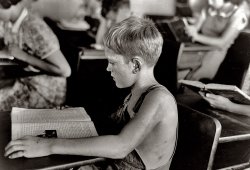
- Candy, Electricity: 1940
- ... appearance by Reddy Kilowatt. Medium format negative by Russell Lee. View full size.
Reddy has left the building And his building ... Posted by Dave - 09/02/2018 - 10:18am -
![Candy, Electricity: 1940 September 1940. "Main street in Montrose, Colorado." Special guest appearance by Reddy Kilowatt. Medium format negative by Russell Lee. View full size.
Reddy has left the buildingAnd his building has left as well, but the adjacent buildings beyond it appear to have survived. Interestingly, the bank location is still still a bank, but the beautiful old structure is long gone.
Car IDL-R: 1937 DeSoto, 1936 Ford, 1931 Chevrolet, 1930 Chevrolet, 1936 Chevrolet, 1938 Chevrolet, Buick?, 1937 Chevrolet, 1940 Ford, 1937 Hudson
Electric co-opshttp://www.montrosehistory.org/western-colorado-power-company
Interesting history of providing power to rural areas. Few people realize electric cooperatives supply power to over half of the US land mass.
[Almost three-quarters of the country by land area, but only 11 percent of kilowatt-hours consumed. - Dave]
(The Gallery, Russell Lee, Small Towns, Stores & Markets)](https://www.shorpy.com/files/images/SHORPY-8b26212a.thumbnail.jpg)
- Pie Town Parley: 1940
- ... Pie Town, New Mexico." Medium format acetate negative by Russell Lee for the Farm Security Administration. View full size.
Night Time is ... Posted by Dave - 06/13/2020 - 12:40pm -
![Pie Town Parley: 1940 October 1940. "Farm family after evening meal. Pie Town, New Mexico." Medium format acetate negative by Russell Lee for the Farm Security Administration. View full size.
Night Time is the Best TimeI love the atmosphere that the photographer achieved with the balance between light and dark, and the interactions between the people. Well done!
It doesn't get any betterIt's just a beautiful photograph and a beautiful moment, especially the engagement between the two women.
Where the men are laconicMy mother comes from a ranching and farming family a little south of Pie Town. I can say with certainty that the aforementioned engagement between the women is partly because those two men didn't say more than six sentences each throughout dinner. And the words "Fine", "Yes", and "No" constitute sentences.
Double word scoreEvery single photo of a table lit by a kerosene lamp reminds me of my dad's story of playing Scrabble by kerosene lamp during Hurricane Carla in 1961. It's a story I've heard in various forms for as long as I've been playing Scrabble, and I'm sure the final version will be told in the memoir he says he's writing. Oh, but unlike the residents of Pie Town, they had electricity when there wasn't a hurricane, right? Well, yeah. He also has childhood memories of his grandmother's place in West Texas, before the REA.
And then there's the story of the stray cow.
Have to sayI can't think of a better photograph on this site. Old friends relaxing after a long day. Wow!
Questions remainAre the older couple parents of the young woman or the man? Whose house are they at or do they share a domicile? Is this a nightly affair or is it weekly? An aspiring writer could run far with this image.
That map tho.I wish I could see a detailed version!
Gogh's "Potato eaters"Real life reenactment, if ever was the one.
Keeping John D. Rockefeller in businessThe table lamp looks to be a Rayo round-wick model with an Argand burner. Rayos were made by Bradley & Hubbard and marketed by Standard Oil; there is a story that a free Rayo lamp came with a purchase of 15 gallons or more of Standard kerosene. Rayos have a rep among collectors as fuel hogs, which quite possibly is why Standard Oil got involved with them in the first place. They became much less popular after 1907, when the Aladdin lamp combined an Argand burner with a Welsbach rare-earth mantle to produce a better and more economical light.
Amazing imageI don't often wonder about technical aspects in most photos, but I would love to know the details on how Lee captured and processed this image so perfectly under these conditions.
[A lot of the processing was by Photoshop, a few hours ago. - Dave]
Reminds me of Hopper's "Nighthawks"I'm aware of the power of the image having neutralized any distracting surroundings by darkness so that you can't help but let the faces tell the story. I'm thinking of Malcolm Gladwell's book, Blink, and how universal are the expressions of our faces. This image is captivating me.
"A lot of the processing was by Photoshop"Photoshop truly is amazing. I looked up this photo on the LoC website and saw just how dark and low in detail it appears from the original negative. The astonishing thing is that all the detail actually was recorded; it's just that film and processing weren't up to recovering it. Dave's restoration augments Lee's talent.
Much as I dream of the past, today has its wonders.
[Any "recovering" of detail would have happened in the darkroom when the negative was printed. - Dave]
Agreed: burning, dodging and other tricks were routine in any darkroom. But even the most artful enlarger artisan would be very hard pressed to ever create a finished print to rival what we can do in Photoshop in seconds.
PainterlyRembrandt lighting a couple of centuries later.
(The Gallery, Kitchens etc., Pie Town, Rural America, Russell Lee)](https://www.shorpy.com/files/images/SHORPY-8b38165a.thumbnail.jpg)
- Telluride: 1940
- ... at Telluride, Colorado." Medium format negative by Russell Lee for the Farm Security Administration. View full size.
This Property ... Posted by Dave - 09/30/2018 - 7:49am -
![Telluride: 1940 September 1940. "Dilapidated buildings at Telluride, Colorado." Medium format negative by Russell Lee for the Farm Security Administration. View full size.
This Property is Condemned. Part OneJust needs a leading man in the scene. Replayed everywhere in the USA.
It's all in how you say itA certain conductor, as his Rio Grande Southern train approached the town, would go through the coach and announce the next stop as, "To Hell You Ride".
Our young damsel in the photo looks like she'd rather be somewhere else. Hope she's in a better place now.
705 is really 205The address sign that looks to me like "705" is probably really "205." As in 205 E. Colorado Avenue. The vacant building with the suspicious young lady sitting in front is now gone, and they seem to have raised the street level, but the shop to the left is still there. In the 2014 Google view it's the "Telluride Music Co." but appears to be a cafe now. You might still be able to get a Big Smile there, but these days that might mean putting something... different in your pipe.
Phoenix BeanThis building looks to me like the current Phoenix Bean coffee shop (image below). It was originally a hardware store.
[This is the building to the left, with the SHERIDAN BEER sign in the window. - Dave]
Google and Bing say "no"I thought it would be interesting to see if these buildings survived the "gentrification" of Telluride after it became a ski resort, however, neither Bing nor Google maps have street view in Telluride. Hard to believe, but true.
Except for one small strip of Colorado Avenue (about a block) Google does not show any streetviews for Telluride in my Google in Indiana. Yet I see one below. WTF Google in Indiana?
Been to Telluride It's come up in the world.
NestsOn the more ornate building there a few nests above the girl. I will guess they are from wasps but the opening looks different than what I usually see.
[Those are swallow nests. Made by birds, not bees. - Dave]
(The Gallery, Russell Lee, Stores & Markets)](https://www.shorpy.com/files/images/SHORPY-8b26105a.thumbnail.jpg)
- Imperial Hotel: 1940
- ... during its heyday." Medium format acetate negative by Russell Lee for the Farm Security Administration. View full size.
Still Grand ... Posted by Dave - 04/30/2020 - 2:09pm -
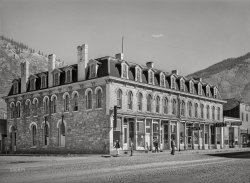
- Washstand: 1936
- ... house." View full size. Medium format negative by Russell Lee.
(The Gallery, Kitchens etc., Rural America, Russell Lee) ... Posted by Dave - 11/07/2008 - 10:20pm -
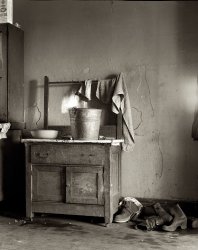
- Biwabik Derelict: 1937
- ... building. Biwabik, Minnesota." Medium format negative by Russell Lee for the Resettlement Administration. View full size.
Vacant for a ... Posted by Dave - 12/30/2014 - 11:35am -
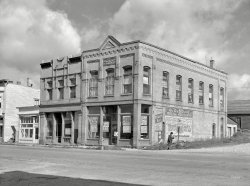
- You Like It: 1942
- ... Idaho." Brought to you by 7up. Medium format negative by Russell Lee for the Office of War Information. View full size.
A Street The ... Posted by Dave - 01/04/2015 - 12:55pm -
![You Like It: 1942 August 1942. "Bike rack in Idaho Falls, Idaho." Brought to you by 7up. Medium format negative by Russell Lee for the Office of War Information. View full size.
A StreetThe IOOF building is at 393 N. Park Ave, this view was taken from A Street looking East.
Woolworth's is gone as is the arched opening, though you can still see the outline of both.
You'll put your eye outwith the handlebars on the far right one. Also didn't expect to see all the locks in 1942.
Being kidsI'm guessing these are the main means of transportation for all the kids that are spending their allowance at Woolworth's while this picture was being taken. I loved Woolworth's as one received a good quality item (usually made in the USA) at a bargain price and I shopped there until they went out of business. Even their lunch counters and soda fountains were fabulous and now gone forever. I am still using a carbon steel American-made potato peeler which fits comfortably in one's hand and is still as sharp as when new, which I bought there in 1963 for 35 cents.
Handlebar Adjustments for individualityUp high like a Texas Longhorn. Down low for that racing bike look. Regular for the majority of bikes.
Looks like a couple of Schwinn bikes are represented. (far right and middle)
Bike locks to ward off free rides or thieves?
Seat springs for those roads with tire ruts.
Single speeds and coaster brakes for all.
Movie theater valet parking, maybeI wonder if the kids who own those bicycles are more interested in what's on the silver screen than Woolworth's latest incoming shipment of guppies and turtles??
Saturday MorningFrom street view the bike rack appears to be pretty much in front of the Paramount Theatre
Locks?Someone mentioned bike locks, I don't see any.
[Here are two of the four. -tterrace]
Bike locking, Then and NowThanks for those pictures, Tterrace, because I didn't see those locks, either. Silly me, I was looking at the *front* wheels to see where the bikes were locked to the bike rack. But it looks like back in the day, kids just locked the rear wheels. I guess maybe bike thieves back then never thought of simply walking away with a bike while holding the rear wheel off the ground, and then hacksawing the lock off at their leisure, away from prying eyes.
Bike seats Bike seats look a lot more comfortable in those days. This scene could have been fifteen years later and one of those bikes mine. Of course, my butt was younger, too. Great picture!
May be an ElginThe men's bicycle which is fourth from the left strongly resembles the old hand-me-down Elgin which was my first bicycle. The distinguishing features are the extra cross bar on the frame and the arched front fender braces attached at the top of the steering tube. The bike in the photo appears to have been repainted, as mine had pinstripes and stars on the fenders. Elgin was a Sears & Roebuck make.
The bike was very old when I got it as a hand-me-down from an older cousin in 1965. Little did I know that it was as old as the 1940's! Those bicycles were extremely heavy and, as another poster remarked, had only one speed. They had to be walked up hills which a modern 10-speed would take in stride.
Hiyo SilverThe bike on the right is obviously ridden by the Lone Ranger, or at least a Lone Ranger fan.
BuildingThe bikes are cool, but the building still there after 70 + years and still looking nice is amazing. I want to go to that town to shop at the antique store on the corner!
Paramount TheatreThat bike rack was in front of the Paramount Theatre. Went there often in my youth! The schools would sell summer movie passes (Saturday matinees)! I remember seeing "The Ghost and Mr. Chicken"! It was usually packed to the back of the balcony with screaming kids. Usually too loud to hear the movie! Total mayhem! The Paramount Theatre was out of business and dilapidated for many years. I helped clean it out as part of an Eagle Project. It has since been restored as a performing arts center. The official name now is the Colonial Theater Willard Arts Center.
(The Gallery, Bicycles, Russell Lee, Stores & Markets)](https://www.shorpy.com/files/images/SHORPY-8c32614a.thumbnail.jpg)
- Ripe Two Mottoes: 1941
- ... by Negro, Southside Chicago." Medium format negative by Russell Lee for the Farm Security Administration. View full size.
Somebody was ... Posted by Dave - 10/30/2018 - 12:24pm -
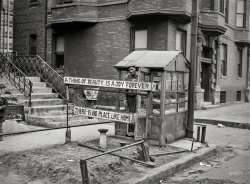
- Beach Haven: 1939
- ... of tourist courts." Medium format acetate negative by Russell Lee. View full size.
(The Gallery, Russell Lee) ... Posted by Dave - 07/19/2021 - 10:52pm -
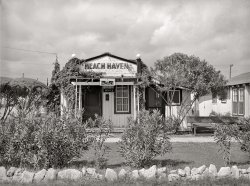
- Pie Town Still Life: 1940
- ... Mexico. View full size. 4x5 Kodachrome transparency by Russell Lee, one of hundreds of photos he made of Pie Town for the Farm Security ... Posted by Dave - 08/10/2012 - 4:14pm -
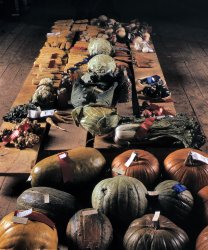
- Name Your Poison: 1939
- ... caffeine, nicotine, protein. Medium format negative by Russell Lee for the Farm Security Administration. View full size.
And some more ... Posted by Dave - 06/16/2018 - 3:23pm -
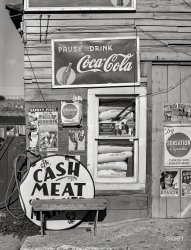
- Grace in Color: 1920
- ... photos by many documentary photographers (Dorothea Lange, Russell Lee et al) later came to be seen as high art, and rightly so. As Dave keeps ... Posted by Fredric Falcon - 06/26/2009 - 4:09pm -
![Grace in Color: 1920 A colorized version of this 1920 photo of actress Grace Valentine by the Bain News Service. View full size. More in the Colorized Gallery.
Color me impressedYes, great job. I still have my set of photo oils & pencils and have gotten good results from time to time. I've never really gotten the hang of getting the "right" look using photoshop.
CuriousIt would be interesting if we can find out, from Akvis, how many hits they get today and how many they would normally get. I visited the site just to see how it works, but I don't have many black and white photos.
A Fine JobA fine job of colorizing. It is interesting to compare the colorized photos in the gallery with the black & white counterparts. Would you share the name of the program you use for colorization?
Color or B/W, it still hurts to look at her feet.Nice colorization work and Grace was a stunner, but it still causes me pain to look at her misshapen tootsies. Ouch!! My 50 year old male feet with 30 years spent in steel-toed boots look healthier.
Akvis ColoriageThanks for all the compliments! I never expected my work would get such recognition here! The software I use is called Coloriage by Akvis. It comes as a standalone application and/or a plugin for Photoshop and many other photo-editing programs. The site has a short movie showing how easy it is to use.
Coloriage has a selection of colors for complexions, hair, eyes, lips, etc., plus wood, sky, water, fabric, bricks, and so on. You can save your color strokes if you want to exit the program and resume the coloring later. When you're ready to color the photo, just click one button and the job is done. You can load another copy of the same black and white photo, reload the saved strokes, and then change the color of any of them very easily.
And no, I'm not affiliated with the Akvis company at all nor am I being paid for these remarks.
Miguel Chavez asked how I know what color to give each pixel. I just use my intuition. It's all guesswork. I put on a color and then view the results. If it doesn't look right, I select another one. Sooner or later I get realistic colors. It's fun.
Was this photo taken...before the invention of the pedicure? That left foot looks like it needs a little TLC.
I used to colorize my black and white photos with Marshall oils, a slow tedious process, using Q-Tips and patience. Photoshop has changed just about everything I suppose. Yet this photo looks to either be hand tinted or slightly off due to the green hue on the lower edge of the seat slab. The blue pottery job is very nice.
Most impressive!I definitely must congratulate you on this fine job of colorizing these old pictures. It's amazing! they really look natural and unlike the hand-colorized photos I know, in these you don't see the underlying black and white pixels.
How do you determine what color should be given to each pixel? How do you do this?? It's definitely impressive!
Wonderful job! That is a great job Fredric. I would like to see a photo of Atlanta during the Civil War colorized if it is possible. I look at the old black and white photos and Atlanta looks so drab and it would be great to see it in true to life color.
Robert Brock
Akvis ColoriageFrederick, thank you for sharing the name of the program you use. I am webmaster for an historical society and have been instrumental in providing photograph displays for the society at a local library. I have applied for the Akvis free license program for the society. My plan is to use colorized versions of historic photos alongside the black and white versions.
Best colourizing I've ever seenNice work Fredric. You avoided those awful tobacco and lilac-y colours often used. Very natural looking.
You should run with this skill of yours.
Tint CampIn anpther thread someone said the tones of this photo -- particularly skin -- were too bold. Quite right, if the goal were realism or an accurate reproduction of Ms. V. as she lived and breathed.
OTOH, I find this colorization quite pleasing as it is; after all, she was allegedly an actress, and these tonal values sure look like a period movie poster!
Travesty!Ok, very clever, but an abomination none the less. Colourisation has no place on this blog, or anywhere else in the known universe. Please post the original.
[Somebody's not paying attention. Read the caption, click the link, see the original. - Dave]
Innocent MerrimentOld documentary photos from the Library of Congress are not black and white "works of art" by Ansel Adams or Frank Capra, even though some of the brilliant photos by many documentary photographers (Dorothea Lange, Russell Lee et al) later came to be seen as high art, and rightly so. As Dave keeps saying, the originals are intact, and all have been seen here first in all their original panchromatic grayscale splendor. But the world that monochrome photos and newsreels recorded was not Dorothy Gale's Kansas, and many of us enjoy imagining the color-saturated world of our ancestors. Go for it, colorists! Get it right, or not -- who's to say, and who cares? It's simply another part of the fun, and you're getting pretty good at it. No photographers or their reputations were harmed in the making of these pictures, unlike, say, a dumb colorized version of the Kansas scenes in the Wizard of Oz.
Fine looking lady.Someone's grandmother or great-grandmother was a fine looking lady. She also has a pleasant demeanor about her. I think I would have liked her! Colorization? Who cares I like it.
Stop coloring these pictures!!!I must put in my two cents worth. Please stop coloring these pictures! To you it just seems like an interesting job, fun for a bit and then thrown away. To me, all you do is ruin the historical value of the pics you mess with. Please find another hobby, like pulling wings off birds, to play with....
[Might it be time for a switch to decaf? - Dave]
Tempest in a polychrome teapotYes, I don't like colorized films. It does break up some fond memories of watching black-and-white vintage films. On the other hand I had to admire the way you reproduce the color scheme of most magazines of the period. The colors are that of some 1950's Playboy centerfold. Well done Dave. Photography is Art and always has been.
[Thank you but -- let's note that this is Fredric's work, not Dave's. - Dave]
What Pictures???"All you do is ruin the historical value of the pics you mess with." Now, waita minnit! The reaction of Tipster seems to assume, despite all reassurances, that actual historical photos, the for-real original prints or negatives, are being colored. Only that action could ruin their historical value. Descending to personal information beyond that on my member bio, I am a former museum curator with more than 35 years in art history and historical preservation and conservation behind me. Like my colleagues in many other museums and archives, a huge hunk of my life has been given to preserving "historical value" wherever I can. I mention this only to provide context when I say, "Honey-Lamb, lighten up!" What's being colored is DIGITAL SCANS of historical photos, a bunch of ones and zeros in a computer hard drive, not photos. This is Virtual Reality only. History is not being messed with or destroyed. What's happening here is that ideas about history are being presented and discussed. No "real" historical artifacts are involved except as a starting point of reference for the discussion. If some of these ideas are so unpleasant to you, Turn The Page. All the photos that have been colored are waiting for you in their original states (less some scratches and fading and ugly spots digitally removed for presentation), miraculously unharmed.
Colourized vs the Original PhotoIf you prefer bright modern colour and do not really appreciate the older photos for just what they are, their depth, what they tell us and just how wonderful they are, you can always look at modern photos, no?
Dave you colourize very well, the best I have ever seen, which is like being a charismatic cult leader. Get me?
--what about a link to the original on the page when a colourized pic is posted or the other way around.
[For each of the colorized photos, there already is a link to the original image. (Doesn't anyone read the captions?) Also I am not the colorizer of any of these pictures. The name of the poster is above each image. - Dave]
Color Me GoneI always prefer seeing the pics in black-and-white and letting my imagination take over, but I do view the colorized versions. I don't like them, but I will take a glance.
It's like driving by a nasty car accident or seeing your kindergarten teacher naked (just random theorizing). Don't like, but due to intrigue will take a peek.
(ShorpyBlog, Member Gallery, Colorized Photos)](https://www.shorpy.com/files/images/LoungingFlapperInBathingSuit.thumbnail.jpg)
- Carnivale: 1941
- ... for the Fourth of July celebration." Acetate negative by Russell Lee for the Farm Security Administration. View full size.
High fashion ... Posted by Dave - 02/22/2019 - 4:14pm -
![Carnivale: 1941 July 1941. "People in Vale, Oregon, for the Fourth of July celebration." Acetate negative by Russell Lee for the Farm Security Administration. View full size.
High fashionThe clothing here is outstanding. I sometimes force myself to look at slideshows of couture extravaganzas, with all the runway nonsense, and this stuff here, in Oregon in 1941, is downright beautiful. All the clothing looks skillfully homemade or easily purchased. That woman with glasses in front, holding the little boy’s hand, is just plain gorgeous. That blouse, the buttons, that waistband, the pants, even the saddle shoes – she’s a knockout.
[Her blouse looks like rayon. - Dave]
SimplicitySometimes I forget there was a time when everyone's clothing didn't bombard us with brand names and logos.
Main street U.S.A. Much of it survives.
Vale, Oregon scenes - July 4, 1941There's video below for anyone interested in seeing a wonderful slideshow of pictures from that day in Vale.
Seems most of the folks shown in the photo above are walking away (south) from a then-finished parade, as it was held on "A Street" to the north (east/west where the corner for the Vale Hotel is in the background). Maybe hurrying towards the fair?
[The fair is in the photo. See the Ferris wheel on the right? - Dave]
(The Gallery, July 4, Kids, Russell Lee, Small Towns)](https://www.shorpy.com/files/images/SHORPY-8c01704a.thumbnail.jpg)
- Serious Fun: 1942
- ... For a paltry dime, BEHOLD the Serious Boy! Photo by Russell Lee for the Office of War Information. View full size.
And For a MERE ... Posted by Dave - 03/13/2016 - 8:51pm -
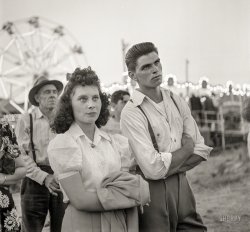
- Stamps Gas Coke: 1937
- ... One-stop shopping for a variety of needs. Photo by Russell Lee, Resettlement Administration. View full size.
All you need to make ... Posted by Dave - 05/23/2013 - 1:30pm -
![Stamps Gas Coke: 1937 August 1937. "Post office in Gemmell, Minnesota." One-stop shopping for a variety of needs. Photo by Russell Lee, Resettlement Administration. View full size.
All you need to make you GoEx-Lax, orange juice and gasoline. That's all I need for speed. I miss seeing these little combination stores and post offices. They're about all gone from our area. One I visited just a few years ago (now closed) still had items in stock with prices dating to the '50s and '60s.
All of ThatPlus Ex-Lax.
LeadI never noticed that they warned about gasoline having lead since the thirties. But it took till the eighties till they finally removed the stuff.
[See Dave's explanation here. -tterrace]
Carnation, Pet, Borden -- those I've seen, but how could I have reached senescence without knowing that Armour also made condensed milk?
TEL or EthylThe "lead" that was added to gasoline was not metallic lead nor a simple metal salt. It was a more complex organic compound known at tetraethyllead (aka TEL). The commercial additive blended this with two other components along with a dye. Check out https://en.wikipedia.org/wiki/Tetraethyllead for a more detailed explanation.
Boom, burn, bustGemmell was a lumber boomtown. A forest fire hastened its demise, before Lee photographed everything left of any importance. According to a middle school history project, at its peak Gemmell had 2,000 citizens, seventeen hotels, an ice cream parlor, two schools, four or more restaurants, one gas station, one church, more than ten sawmills, and a number of other businesses. Lee reported that there were 500 citizens at the time of his visit, which seems generous. Today, it's more of a townsite than a town.
(The Gallery, Gas Stations, Russell Lee, Stores & Markets)](https://www.shorpy.com/files/images/SHORPY_8b36773a.thumbnail.jpg)
- The Last Roundup: 1939
- ... after the roundup. Cattle ranch near Marfa, Texas." Photo: Russell Lee for the Farm Security Administration. View full size.
Rip Torn Jr. ... Posted by Dave - 03/25/2018 - 5:35pm -
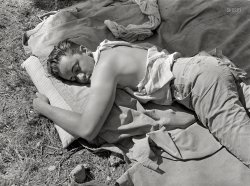
- Small-Mart: 1938
- ... Baby Bowel Corrective. 35mm negative by the peripatetic Russell Lee. View full size.
Sheesh! For a moment my initial thought about ... Posted by Dave - 05/31/2015 - 11:28am -
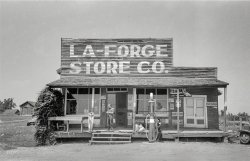
- Blades, Combs, Laces: 1939
- ... Waco, Texas." View full size. 35mm nitrate negative by Russell Lee for the Farm Security Administration.
Razors Looks like he is ... Posted by Dave - 07/05/2009 - 1:58am -
![Blades, Combs, Laces: 1939 November 1939. "Street vendor's goods. Waco, Texas." View full size. 35mm nitrate negative by Russell Lee for the Farm Security Administration.
RazorsLooks like he is selling a couple of Gem Razors. I can tell by zooming in a bit that the G-P Blades are single edge (for the Gem Razors he is selling) but he's also got several brands of double edge blades...the Fan blades, the Smith Blades...which would go in a Gillette Tech or Aristocrat (which he doesn't seem to stock in his little box). I'm a razor nerd...I wish I could run across some kid selling these on the street today. I'd buy him out.
Josh
PS- Those Gem razors are kind of hard to use these days. The blades you can get for them are not always the best quality. If you've ever seen Treet razor blades in the drugstore (you might have bought them to use as a scraper, or to put in a utility knife maybe or for a crafts project) that is what you can get today and that's about it. They tend to be a bit rough. Double edge blades are still easy to find though and high quality blades are relatively easy to source on the internet, allowing these great old razors to still perform today just like they did way back then. One of my favorite razors is a Gillette Tech from a little later than this (1940s) that shaves like a dream and looks brand new 60 years later. They don't make them like this anymore.
[Click below to enlarge. - Dave]
John RuskinWas the John Ruskin box from razors, or cigars (it looks a bit like a cigar box), or from something else entirely? How odd to contemplate an America in which John Ruskin's name could be used to sell anything!
I imagine his name was associated with sophistication in an era before everything went lowbrow.
[Cigar box. - Dave]
SharpI'm a razor nerd also. Interesting picture.
(The Gallery, Great Depression, Russell Lee)](https://www.shorpy.com/files/images/8a27487u_0.thumbnail.jpg)
- Cajun Cooking: 1938
- ... Louisiana." View full size. Medium format negative by Russell Lee.
Where's Hank? Love this photo. I'm looking around for a young ... Posted by Dave - 04/13/2008 - 5:55pm -
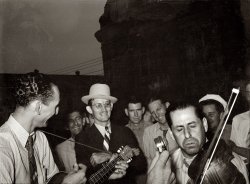
- Store Greeter: 1942
- ... County, Montana. Oat harvest." Medium format negative by Russell Lee for the Office of War Information. View full size.
Milnut ... Posted by Dave - 07/18/2017 - 11:53am -
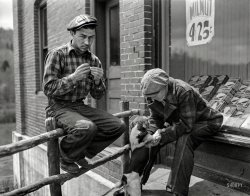
- Mother and Child: 1936
- ... Township." View full size. 35mm nitrate negative by Russell Lee for the Resettlement Administration.
Mary (Walker) & Wallace ... on her last day on earth.
(The Gallery, Rural America, Russell Lee) ... Posted by Dave - 04/10/2008 - 11:40am -
